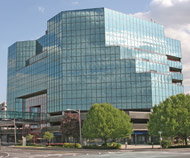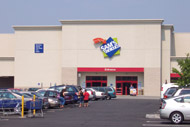|
FEATURE ARTICLE, SEPTEMBER 2005
MIXED-USE PROJECTS FLOWER IN THE GARDEN STATE
Well planned, diverse mixed-use projects are proving to be big draws in New Jersey.
Kevin Jeselnik
The prevalence of mixed-use projects in the Northeast is no head scratcher. In the most densely populated region of the nation, the development of convenient and diverse commercial and residential developments reduces clutter and curbs suburban sprawl. A growing number of developers are seeking to integrate multiple facets into their projects to draw traffic. A strong retail component greatly enhances the success of office space, and the presence of a quality hotel will drive more people to restaurant and retail locations. A complementary mix of various commercial sectors phenomenally improves and projects chances for success. The current push to draw people back into the urban environment has created a number of opportunities for developers. Northeast Real Estate Business takes a look at two very different projects in New Jersey that illustrate the strengths and benefits of a well planned mixed-use development.
Harmon Meadow
 |
300 Lighting Way, one of seven office buildings located in Hartz Mountain Industries’ Harmon Meadow.
|
|
In the early 1980s, Hartz Mountain Industries began developing an expansive project in Secaucus, New Jersey, approximately 3 miles from the Lincoln Tunnel. Emanuel Stern, COO of Secaucus-based Hartz Mountain, saw enormous potential for the site to house quality office space and retail just miles from Manhattan, offering a level of convenience not often found in the Big Apple. Harmon Meadow was developed as a 175-acre collection of office, hotel, entertainment and retail components.
As the project progressed, it evolved into one of the first mixed-use projects of its kind, changing to provide greater benefits to its tenants and the surrounding community. But to enhance Harmon Meadow’s cachet, Hartz Mountain knew that it needed to offer a greater mix of services. In 1990, the company developed the Meadowlands Exposition Center, a convention center, to augment the retailers and businesses.
 |
Wal-Mart opened in Hartz Mountain Industries’ 175-acre Harmon Meadow in 2004.
|
|
Though Harmon Meadow in its initial form offered an array of services, it was dominated by its smaller retail offerings, office and hotel components. Around 2001 and 2002, Hartz Mountain began working to reinvent the project as a true mixed-use development. Much of the existing space was rezoned for retail use and the repositioning efforts took off.
“At one point, we were zoned for office, but frankly, for 10 years we were not able to get an office tenant we deemed appropriate,” Stern says. With existing office space occupied by top-tier clients such as UBS, Kenneth Cole, Mellon Consultants, Equitable Life Assurance Society of America and the National Basketball Association, the company could be picky with new office development. Additionally, Stern felt that the need for retail far outweighed the need for new office space. So, approximately 3 to 4 years ago, the company finally answered the call from the many retailers that had shown a desire to locate in Harmon Meadow for years.
 |
The Marshalls HomeGoods at Harmon Meadow.
|
|
Today, the project encompasses approximately 2 million square feet of office space in seven buildings, seven hotels, a convention center, 10 restaurants and approximately 90 retailers in more than 125 buildings.
The retail development has been booming over the past 2 years. The rezoning paved the way for the big boxes and mid-sized retailers to enter Harmon Meadow. “For the most part, the world of the national retailer now is not those small inline stores, but large box category killers,” Stern says. “So the appetite has been for the 20,000 to 100,000-square-foot stores.”
 |
Sam’s Club in Harmon Meadow.
|
|
Wal-Mart, Sam’s Club, Bonefish Grill and Cheeseburger in Paradise opened in the past 18 months. A.C. Moore and Red Lobster both opened this summer, and Linens ‘n Things and PetsMart will open in the fall.
The new tenants have added a new layer to the eclectic mix of users in Harmon Meadow. The project is a fine example of different sectors complementing and driving business. The reinvention invigorated a mature development and attracted a new group of consumers.
“I think the re-tenanting is just a generational upgrading of tenants and of concepts,” Stern explains. “After your [project] is 15 years old or more, it’s time to refresh and bring new concepts and create new opportunities.”
Somerville Towne Center
Approximately 40 miles west of Secaucus, Edgewood Properties is embarking on a revitalization effort in Somerville, New Jersey. The Piscataway, New Jersey-based development and property management company is redeveloping a 25-year old grocery-anchored shopping center located on Main Street across from a major commuter train station. Edgewood is planning to develop Somerville Towne Center, featuring 136,000 square feet of retail space, 73,000 square feet of office space, 265 luxury apartment units and two parking garages on the site.
 |
Edgewood Properties is developing Somerville Towne Center, a collection of luxury apartments, second-floor office space and retail on the site of an existing obsolete retail development in Somerville, New Jersey.
|
|
The Somerville Planning Board approved the company’s plans for the project, which is estimated to cost approximately $66 million, in April and Edgewood began negotiating with existing tenants and preparing for the redevelopment. The location drove the decision to take on the redevelopment.
“It is a very, very strong market; it’s surrounded by several affluent communities, including Bridgewater,” says Joe Morris, director of sales and marketing for Edgewood’s commercial properties. “It’s a market, like some downtowns in New Jersey that have suffered over the years, that has fallen victim to the regional markets, the sites on major highways, and we really saw a tremendous opportunity for a revitalization of the downtown.”
The existing center was built in the 1970s and is architecturally dated. Edgewood wants to modernize the property and introduce a variety of uses. “I could not describe a better location,” Morris notes, “but from an aesthetic standpoint, the depths are wrong, the sight lines are wrong and access is very poor.” The existing structure will be completely demolished once the current tenants move. Once the demolition is complete, the project will be developed in one phase, with the multifamily likely coming online first.
The city has gotten behind the project and is working closely to aid Edgewood in the development. The city’s involvement is another example of the move to reinvigorate the downtown core in many Northeast cities. “The town has been very cooperative; they’ve shared the vision of this project,” Morris says. “In fact, I’d like to go on the record as saying we have shared their vision. This is something that this town has wanted and we feel lucky to be involved.”
The office component will be on the second floor of the development and will be available for an array of users. The Somerset Medical Center is located in close proximity and Morris believes that the office space can support any expansion needs that may come from the medical center or its doctors. The local courthouse is also nearby, and Edgewood is hoping to attract the legal community as well. The need for quality Class A product is strong enough to support the new development.
The company currently is leasing the retail space, which likely will retain a grocery component. The rest of the retail will be occupied by high-end clientele, including restaurants and businesses that will offer a variety of services to the market. “Co-tenancy is everything these days,” Morris says. “You have to offer the right balance of retailers and restaurants and service-oriented users. You have to have strong access and good visibility and it has to be in a convenient location. Mixing in the residential portion, it sounds complicated, but it’s not. People want ease in their life. Having transportation in walking distance, having all of your shops and restaurants in a good, park-like downtown setting is very appealing.”
For the residential component, Edgewood will develop two- and three-bedroom units, as well as a full fitness facility and community center large enough to host 7,500 people. “It will be one of our higher levels for an amenity package, as far as standard features and the architectural enhancements,” says Joe McGinley, who handles all of Edgewood’s residential sales.
Though the project was not designed as a transit-oriented development, the benefit of having a rail line across the street is sizeable, says McGinley. “We really like to take full advantage of the facilities that surround us. We feel the project would have been successful had there not been a rail line, but obviously, that’s one of the real key ingredients that Edgewood Properties looks for — where are the people coming from, where are they going and how do we serve them?”
©2005 France Publications, Inc. Duplication
or reproduction of this article not permitted without authorization
from France Publications, Inc. For information on reprints
of this article contact Barbara
Sherer at (630) 554-6054.
|
